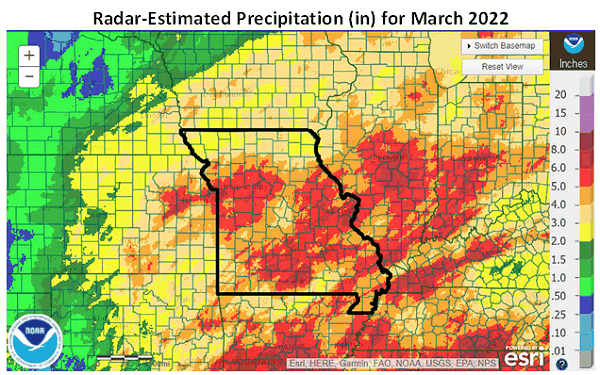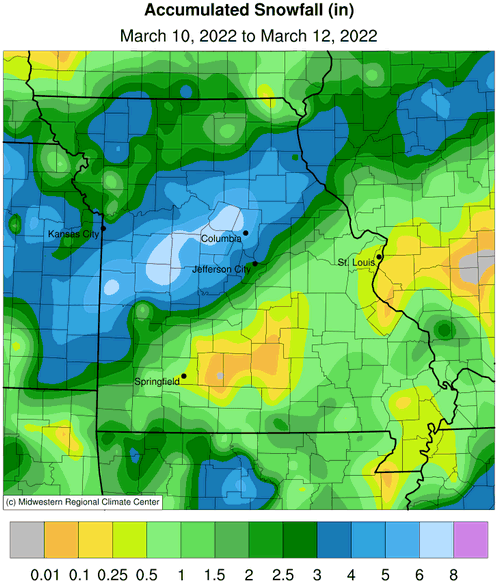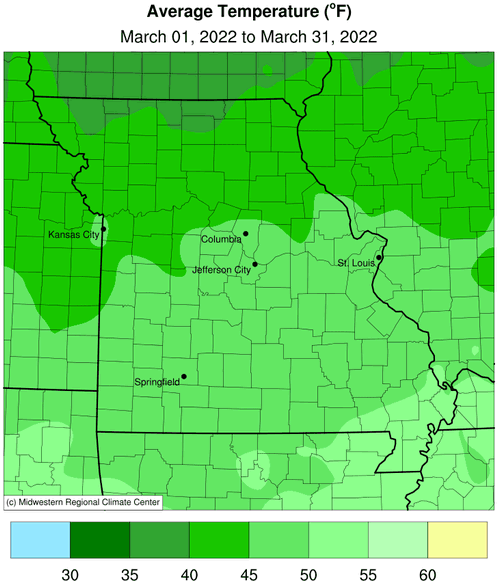
March 2022 Weather and Its Impacts on Missouri
Pat Guinan
State Climatologist
University of Missouri Extension
Alternating periods of above and below normal temperatures dominated the Show Me state during March, much like the previous couple months. A meandering jet stream, oriented northwest to southeast, in the middle of the country, resulted in big temperature swings, Figure 1. According to preliminary data, the statewide average temperature for the month was 46.2°F, or 2.6 degrees above the long-term average. Seven out of the past eight Marches have been above average, Figure 2. It was the first time this year with above average temperatures but 9 out of the past 15 months have been warmer than average, Figure 3.
Preliminary data indicate the average statewide March precipitation total was 4.49 inches, or 1.28 inches above the long-term average. March precipitation has been above average for the past six years, Figure 4. It was the second consecutive wetter than average month; 9 out of the past 15 months have been above average, Figure 5.
March radar estimates indicate heaviest precipitation occurred over west central, east central, south central and southeastern Missouri, Figure 6. Lightest amounts were mostly confined to northern counties. Spring fieldwork activity was limited across the state, especially in the wetter areas. Some of the highest and lowest monthly rain gauge totals are listed in Table 1.
| Missouri March 2022 Precipitation (in.) | |||
| Location | County | Mar 1-31 Precip. (in.) | |
| Highest | Summersville 3.6S | Texas | 8.00 |
| Sedalia Water Plant | Pettis | 7.06 | |
| Jackson 1SW | Cape Girardeau | 6.77 | |
| Poplar Bluff 4.2NW | Butler | 6.60 | |
| Steelville 5.6SW | Crawford | 6.59 | |
| Dixon 5.2NE | Mississippi | 6.57 | |
| Rolla 3.2SSW | Phelps | 6.55 | |
| Lowest | Hopkins 3.9WSW | Nodaway | 2.38 |
| Grant City 0.5NE | Worth | 2.41 | |
| Bethany 1.3NE | Harrison | 2.46 | |
| St. Joseph AP | Buchanan | 2.64 | |
| Princeton 1.4NNE | Mercer | 2.78 | |
| Rosendale 2.6ESE | Andrew | 2.81 | |
| Forest City 6.9N | Holt | 2.83 | |
| Table 1. NWS COOP and CoCoRaHS rain gauge reports. | |||
A significant snow event impacted much of the state on March 10-12, with a band of 3-7 inches impacting parts of west central, central and northeastern Missouri, Figure 7.
The wetter March conditions eliminated any dryness as depicted by the U.S. Drought Monitor map, Figure 8. It was the first time since April 20, 2021 when all of Missouri was free of any dryness or drought category.
A guide to spring frost/freeze probabilities for Missouri can be accessed at the following link:
Missouri Frost Freeze Probabilities Guide http://ipm.missouri.edu/frostfreezeguide/.
The median last spring frost date is defined as the day after which there is a 50 percent chance of a light killing frost (≤32°F). Typically, the last spring frost occurs over northern and central Missouri by April 20 and April 10, respectively. Frosts are more likely to be experienced later in the spring over the Ozarks when compared to central Missouri. The reason for this is due to the higher elevation of the Ozark Plateau which causes cooler temperatures in the Ozark region than would be expected. In fact, some counties in the Ozarks normally do not experience their last frost until the end of April. As the Ozark Plateau transitions to the southeastern lowlands of the Bootheel, the median last spring frost retreats to the first week of April.
Jump to:
- Figure 1
- Figure 2
- Figure 3
- Figure 4
- Figure 5
- Figure 6
- Figure 7
- Figure 8
- Figure 9
- Figure 10
- Figure 11
- Figure 12

Figure 1.

Figure 2.

Figure 3.

Figure 4.

Figure 5.

Figure 6.

Figure 7.

Figure 8.




Source: Pat Guinan, 573-882-5908












